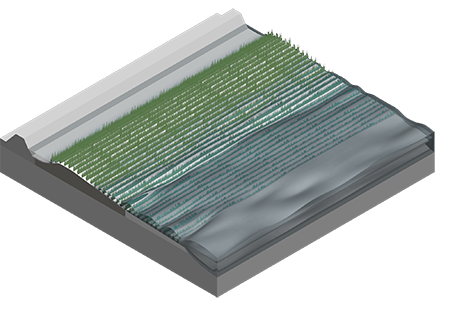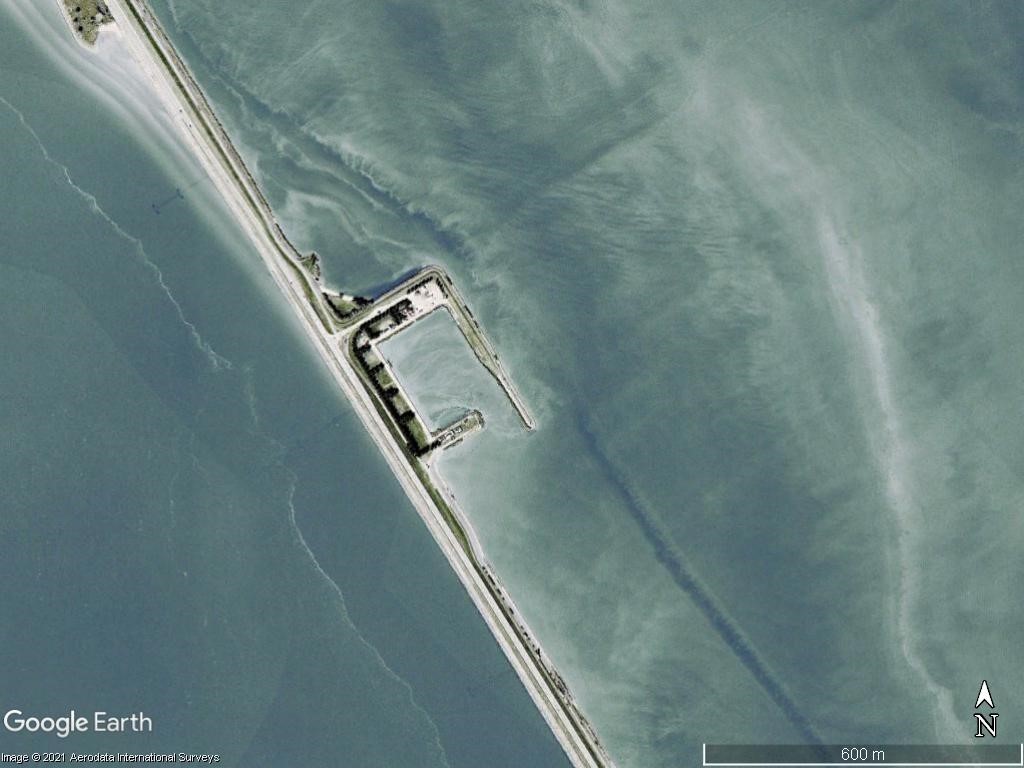Horizontal Levees
A horizontal levee consists of a hardened structure (levee) setback from the coastline with a wide expanse of natural habitat – often a coastal marsh – between the water and the levee. By protecting the coastal habitats and moving the hardened structure back away from the coast, the marshes provide a natural buffering capacity to reduce the impacts of coastal flooding, storm surge and wave action. As a result, the hardened features are reduced in size when compared with levees which do not have a buffer or a setback from the coast. This reduces the overall cost of constructing the levee relative to more traditional approaches. This also maintains the natural coast, allowing for the continued provision of habitat and recreational opportunities associated with marshes and other coastal habitats.
Hazard Mitigation
By including natural habitats on the waterside of a hardened structure, a horizontal levee system reduces coastal erosion issues and shoreline flooding by relying on the ability of the coastal habitats to absorb wave energy and slow down floodwaters. In essence, by including a natural edge, the flood reduction associated with the levee now occurs along a horizontal gradient as well as a vertical one.
Siting Considerations
If a horizontal levee system is being considered in an area without a pre-existing levee, care should be given to ensure the coastal habitat remains intact and is protected to provide the necessary reductions in wave energy during storm events. Wherever possible, aligning the hardened structure of the horizontal levee system with existing topography to take advantage of naturally occurring protective features will improve overall performance.
If a horizontal levee system is being used as a replacement for an existing traditional levee, ensure that the area which will be exposed once the traditional levee is removed is in fact suitable for a successful restoration process. This includes focusing on soil types, topography, and potential hydrologic flow.
Whether it is a new or a replacement levee, it is also important to ensure infrastructure is not constructed and human activity is not undertaken on the storm surge side of the levee which would compromise the health or effectiveness of the marsh. Pipelines, sewer lines, communication infrastructure, old field tiles, or other impediments to a natural hydrological regime may impact the restoration of the coastal habitat and overall effectiveness of the horizontal levee system.

Costs
Estimates are that construction and maintenance costs for a horizontal levee are as much as 40% less than those associated with a traditional waterfront levee. By taking advantage of the wave reduction provided by the coastal marsh on the waterside of the levee, a horizontal levee does not need to be constructed to the same height as a traditional waterfront levee, therefore reducing the cost of materials and construction. Likewise, the impact of storm events on the levee itself are reduced as energy is dissipated before floodwaters come in to contact with the hardened component of the system.
In areas where a waterfront levee is being replaced with a horizontal levee there will be costs associated with the restoration of the coastal marshes which are an essential component of this flood management system.
Local projections of sea level rise and land subsidence will need to be taken in to consideration when siting and designing a horizontal levee system. Ensuring there is sufficient room for coastal habitats to persist over time as sea levels rise will prolong the effective lifetime of this system. Under ideal scenarios, with sufficient sediment and relatively modest amounts of sea level rise, coastal marshes will be able to keep pace with the rate of sea level rise, making a horizontal levee system potentially even more effective over the long term.
Co-Benefits of the Strategy
By design, horizontal levee systems protect, restore, or create coastal habitats and marshes in places where it may otherwise have been under threat. Coastal marshes in particular are tremendously important and biodiverse habitats which provide food and shelter for a number of fish, shellfish, and bird species that have both ecological and economic value.
Moreover, these systems may be designed with a pathway or bike path along the top of the hardened structure, creating recreational opportunities as well as providing access to coastal habitats that would otherwise have been lost through the use of a more traditional levee system. Outdoor recreational opportunities such as hiking, biking, kayaking, fishing, and bird watching are tremendous boons to the local economy and are a major component of the outdoor recreation economy, worth approximately $650 M annually across the United States.
Maintenance Considerations
With horizontal levees the maintenance costs of maintaining traditional levees (landward of the horizontal levee) would be reduced as the direct impact to the levee itself will be lessened. However, it is important to make sure that the natural habitat on the water-side of the levee is healthy and serving its role effectively. As such, there may be some maintenance needs such as removing debris, replacing or restoring vegetation, adding sand and monitoring to ensure materials remain in place and that water quality remains supportive of ecological health. Yearly inspection of the levee structure itself is also required to check for subsidence and to ensure the levee has not diminished in height.

Similar or Complementary Solutions
When a horizontal levee is installed in an area without current hardened infrastructure, it is necessary to preserve the coastal habitats on the water-side of the levee to ensure they are an effective component of the system. If a horizontal levee is being used as a replacement for a more traditional waterfront levee system, it may be necessary to restore the coastal marsh in the land that was previously behind the levee. It is also possible that it will be necessary to move people out of harms way if they were previously protected by a levee that has since been moved back.
Setback levees employ the same fundamental approach as a horizontal levee just in a riverine system.
Additional Considerations
Levee construction and design is often a major construction project and will require a number of permits and authorizations. Of particular importance are a Clean Water Act 404 permit, managed by the United States Army Corps of Engineers, and Clean Water Act 401 certificate, often managed by state agencies. It is also likely that a project will need a FEMA Letter of Map Revision (LOMR), which signifies changes to flood maps based upon the effects of a project.
Depending on the location of a project there may also be a need for permits relating to the Endangered Species Act and Coastal Zone Management Act as well as any state or local land use or permit review requirements.
If habitat restoration needs to occur on the waterside of a horizontal levee there may be a need for local or state permitting of those activities as well.
Additional Resources

